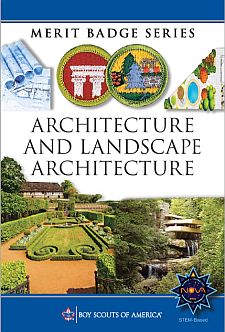- Explain the differences between a landscape architect
and a horticulturist, a landscape contractor, an architect, an urban
planner, and a civil engineer. Give an example of the work each might
do that is unique to that vocation. How might people in these positions
work with a landscape architect?
2. Do ONE of the following:- Visit a landscape architect's office or invite
a landscape architect to your troop meeting to tell about his or
her work. Find out about and discuss the following with your merit
badge counselor:
- What a landscape architect's daily work is like.
- The education one must have to be a professional landscape architect.
- The methods used in developing a design.
- The drawing tools and computer equipment used in design.
- Log on to the American Society of Landscape Architects' Web site at http://www.ASLA.org and find out more about the landscape architecture profession and schools that educate landscape architects. Using documents printed from this Web site, report to your counselor what you have learned.
- Visit a landscape architect's office or invite
a landscape architect to your troop meeting to tell about his or
her work. Find out about and discuss the following with your merit
badge counselor:
- 4. Make a report in the form of a short talk to
your Scout troop on what you found in requirement 3. Discuss the following:
After completing requirement 1, discuss the following with your merit badge counselor:- Tell whether the design had separate spaces, a clear path system, and sun and shade variety.
- Tell about the places to sit, eat, or park
a car.
Discuss how the designated seating, eating, or parking area suited the overall design. - Tell whether you were always comfortable and
protected.
Explain how the design reflected consideration for the comfort, shelter, and security of the users. - Tell about some of the trees, shrubs, and
ground covers used in the design.
Discuss how the choice of trees, shrubs, and ground covers used in the project contributed to its appeal and function.
- 5. Identify five shrubs, five trees, and one ground cover, being sure that you select examples of different shapes, sizes, and textures. With the help of your counselor or a local nursery, choose plants that will grow in your area. Bring pictures of the different planting materials or, if possible, examples of their branches, leaves, or flowers to a troop meeting. Be prepared to tell how you might use each in the design of a landscape.
- 6. Look at and study a place of worship
or school grounds to find the place where most people arrive by bus
or car. Show you can do the following:
- Using a measuring tape, measure and draw the entry and its nearby area using a scale of 1/8 inch equal to 1 foot on an 11-by-17-inch piece of paper. Be sure to include the driveway and the wall and door where people enter the school or place of worship. Indicate any sidewalks, structures, trees, and plants within the study area. Make a copy of this plan to save the original. Do the next two items on copies. , then do 4b and 4c using the copies.
- On one copy, use directional arrows to indicate where the water drains across the site, where ditches occur, and where water stands for a longer period of time.
- Decide how you can make the place safer and more comfortable for those using it. Redesign the area on another copy of the plan. You may want to include new walks, covered waiting areas, benches, space-defining plantings of trees and shrubs, and drainage structures.
- Find out about three career opportunities in landscape architecture. Pick one and find out the education, training, and experience required for this profession. Discuss this with your counselor, and explain why this profession might interest you.
BSA Advancement ID#:
67
Requirements last updated in:
2010
Pamphlet Publication Number:
35857
Pamphlet Stock (SKU) Number:
35822
Pamphlet Revision Date:
2008
| Worksheets for use in working on these requirements: | Format | |
|---|---|---|
| Word Format | PDF Format | |
Page updated on: November 18, 2021









